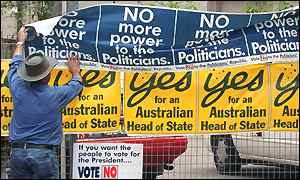It is quite well known that historically, most constitutional referenda in Australia have failed.
The formal requirements – a majority of all votes and a majority in at least four of the six states – are stringent enough. Add to this Australians’ skepticism towards change and we find that out of 44 such referenda since 1901, Australians have said “yeah nah” to 36 of them.
Barry Jones’s Letter to the Australian Academy of Humanities
Dr Jones penned some thoughts last month about his experience as Deputy Chair of the 1998 Constitutional Convention on the Republic. The Fellow of the Australian Academies of Science, Humanities, Engineering and Education sees many parallels between then and now.
As with the Voice, the No to a Republic campaign brought together conservative and radical positions. Both monarchists and those who wanted Australians to directly elect a president urged a no vote in 1999. The same dynamic has Senators Jacinta Price and Lidia Thorpe on the same side in the anti-Voice campaign.
But going beyond political orientations, the Yes/No format itself brings a different dynamic from that of normal elections. Jones estimates that of the 55% of the electorate who opposed the Republic in 1999, 15% were simply not interested and would not have voted in a non-compulsory poll.
That accounts for a striking 27% of no votes. It may be a high estimate, but if accurate it highlights a major barrier faced by the pro-Voice campaign.
“Referenda are very different from elections,” comments Dr Jones. “In principle I have always been in favour of compulsory registration and turning up to vote, but making referenda compulsory distinctly advantages the no vote.”

Analysts in 1999 concluded that a yes vote requires an informed voter with a positive appraisal of the proposal. Either that, or a person supports a politician or other public figure urging a yes vote.
On the other hand, a no vote combines principled with more spontaneous opposition to the proposal at hand. Most no voters in 1999 were supporters of the monarchy, but others expressed sentiments like, “I’d prefer different wording”, “I haven’t thought about the issues”, “What’s in it for me?”, “I am confused”, and, “Normally I vote informal.”
A final feature of 1999 is that it showed how referenda don’t necessarily follow party lines. Then ALP Leader Kim Beazley campaigned for a yes vote, but his electorate voted no. Then PM John Howard campaigned for a no vote along with Tony Abbott, but both of their electorates voted yes.
Australians have supported red-green-teal positions across much of the country in recent years, but despite the backing of ALP governments the Voice remains a very open question.
Feature image courtesy of @floschmaezz via Unsplash.
Sign Up To Our Free Newsletter